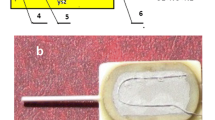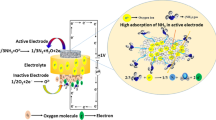Abstract
A dual chamber solid-oxide sensor for simultaneous measurement of methane and water vapor concentrations in CH4 + H2O + N2 gas mixtures was designed and tested in the temperature range of 450–600 °C. The sensor consisted of two isolated electrochemical cells based on yttria-stabilized zirconia (YSZ) electrolyte and Pt electrodes; each cell had a gas chamber connected with the outside atmosphere via a ceramic capillary. Both cells operated in the amperometric mode, one of them was designed for measuring humidity, while the other one for measuring CH4 concentration. The limiting currents of the cells measured in the temperature range of 450–600 °C were shown to rise linearly as concentrations of CH4 and H2O increased. The sensor demonstrated satisfactory response times and good reproducibility of data. The present research shows that the dual chamber amperometric sensor allows to simultaneously measure the methane and water vapor concentrations in CH4 + H2O + N2 gas mixtures and can be used, in particular, for measuring methane humidity.






Similar content being viewed by others
References
Liu X, Cheng S, Liu H, Hu S, Zhang D, Ning H (2012) A survey on gas sensing technology. Sensors 12:9635–9665. https://doi.org/10.3390/s120709635
Demin A, Gorbova E, Brouzgou A, Volkov A, Tsiakaras P (2020) In: Massimiliano Lo Faro (ed) Solid Oxide-Based Electrochemical Devices. Academic Press https://doi.org/10.1016/B978-0-12-818285-7.00006-X
Akbar S, Dutta P, Lee C (2006) High-Temperature Ceramic Gas Sensors: A Review. Int J Appl Ceram Technol 3(4):302–311. https://doi.org/10.1111/j.1744-7402.2006.02084.x
Stetter JR, Li J (2008) Amperometric Gas Sensors – A Review. Chem Rev 108:352–366. https://doi.org/10.1021/cr0681039
Di Bartolomeo E, Grilli ML (2005) YSZ-based electrochemical sensors: From materials preparation to testing in the exhausts of an engine bench test. J Eur Ceram Soc 25:2959–2964
Elumalai P, Plashnitsa VV, Fujio Y, Miura N (2009) Tunable NO2-sensing characteristics of YSZ-based mixed potential-type sensor using Ni1-xCoxO-sensing electrode. J Electrochem Soc 156(9):J288–J293. https://doi.org/10.1149/1.3174390
Anggraini S, Plashnitsa VV, Elumalai P, Breedon M, Miura N (2011) Stabilized zirconia-based planar sensor using coupled oxide (+Au) electrodes for highly selective CO detection. Sensors and Actuators B: Chem 160(1):1273–1281. https://doi.org/10.1016/j.snb.2011.09.062
Park J, Yoon BY, Park CO, Lee WJ, Lee CB (2009) Sensing behavior and mechanism of mixed potential NOx sensors using NiO, NiO(+YSZ) and CuO oxide electrodes. Sensors and Actuators B: Chem 135:516–523. https://doi.org/10.1016/j.snb.2008.10.006
Yoo J, Van Assche FM, Wachsman ED (2006) Temperature-programmed reaction and desorption of the sensor elements of a WO3/YSZ/Pt potentiometric sensor. J Electrochem Soc 153(6):H115–H121. https://doi.org/10.1149/1.2188248
Huberta T, Boon-Brettb L, Blackb G, Banacha U (2011) Hydrogen sensors – A review. Sensors and Actuators B: Chem 157:329–352. https://doi.org/10.1016/j.snb.2011.04.070
Miura N, Sato T, Anggraini S, Ikeda H, Zhuikov S (2014) A review of mixed-potential type zirconia–based gas sensors. Ionics 20:901–925. https://doi.org/10.1007/s11581-014-1140-1
Pasierb P, Rekas M (2009) Solid-state potentiometric gas sensors – current status and future trends. J Solid State Electrochem 13:3–25. https://doi.org/10.1007/s10008-008-0556-9
Volkov A, Gorbova E, Vylkov A, Medvedev D, Demin A, Tsiakaras P (2017) Design and applications of potentiometric sensors based on proton-conducting ceramic materials. A brief review. Sensors and Actuators B: Chem 244:1004–1015. https://doi.org/10.1016/j.snb.2017.01.097
Kalyakin A, Fadeyev G, Demin A, Gorbova E, Brouzgou A, Tsiakaras P, Volkov A (2014) Application of solid oxide proton-conducting electrolytes for amperometric analysis of hydrogen in H2+N2+H2O gas mixtures. Electrochim Acta 141:120–125. https://doi.org/10.1016/j.electacta.2014.06.146
Kalyakin A, Demin A, Volkov A, Brouzgou A, Tsiakaras P (2013) Electrodes for solid electrolyte sensors for the measurement of CO and H2 content in air. Int J Hydrogen Energy 38:13484–13490. https://doi.org/10.1016/j.ijhydene.2013.07.094
Kalyakin A, Fadeyev G, Demin A, Lyagaeva J, Medvedev D, Volkov A, Tsiakaras P (2016) Characterization of proton-conducting electrolyte based on La0.9Sr0.1YO3 and its application in a hydrogen amperometric sensor. Sensors and Actuators B: Chem 225:446–452. https://doi.org/10.1016/j.snb.2015.11.064
Miura N, Wang J, Nakatou M, Elumalai P, Zhuiykov S, Hasei M (2006) High temperature operating characteristics of mixed-potential-type NO2 sensor based on stabilized- zirconia tube and NiO sensing electrode. Sensors and Actuators B: Chem 114:903–909. https://doi.org/10.1016/j.snb.2005.08.009
López-Gándara C, Ramos FM, Cirera A (2009) YSZ-based oxygen sensors and the use of nanomaterials: a review from classical models to current trends. Journal of Sensors 2009 ID 258489 https://doi.org/10.1155/2009/258489
Katahira K, Matsumoto H, Iwahara H, Koide K, Iwamoto T (2000) A solid steam sensor with an electrochemically supplied hydrogen standard using proton-conducting oxides. Sensors and Actuators B: Chem 67:189–193. https://doi.org/10.1016/s0925-4005(00)00400-7
Medvedev D, Kalyakin A, Lyagaeva J, Volkov A (2019) A high-temperature sensor based on CaZr0.95Sc0.05O3–δ for humidity analysis in oxidation atmospheres. J. Solid State Electrochem. 23 (1):73–79 https://doi.org/10.1007/s10008-018-4108-7
Taniguchi N, Kuroha T, Nishimura C, Iijima K (2005) Characteristics of novel BaZr0.4Ce0.4In0.2O3 proton conducting ceramics and their application to hydrogen sensors. Solid State Ionics 176:2979–2983. https://doi.org/10.1016/j.ssi.2005.09.035
Yang YC, Park J, Kim J, Kim Y, Park JO (2010) Oxygen dependency of the hydrogen sensor based on high-temperature proton conductors. Ionics 16:397–402. https://doi.org/10.1007/s11581-010-0421-6
Fadeyev G, Kalyakin A, Gorbova E, Brouzgou A, Demin A, Volkov A, Tsiakaras P (2015) A simple and low-cost amperometric sensor for measuring H2, CO and CH4. Sensor and Actuators B: Chem 221:879–883. https://doi.org/10.1016/j.snb.2015.07.034
Aldhafeeri T, Tran MK, Vrolyk R, Pope M, Fowler M (2020) A review of methane gas detection sensors: recent developments and future perspectives. Inventions 5:28. https://doi.org/10.3390/inventions5030028
Sekhar PK, Kysar J, Brosha EL, Kreller CR (2016) Development and testing of an electrochemical methane sensor. Sensors and Actuators B: Chem 228:162–167. https://doi.org/10.1016/j.snb.2015.12.100
Mangla O, Roy S (2019) Monoclinic zirconium oxide nanostructures having tunable band gap synthesized under extremely non-equilibrium plasma conditions. Proceedings 3: 10 https://doi.org/10.3390/IOCN_2018-1-05486
Liu T, Zhang X, Wang X, Yu J, Li L (2016) A review of zirconia-based solid electrolytes. Ionics 22:2249–2262. https://doi.org/10.1007/s11581-016-1880-1
Vagner P, Guhlke C, Milos V et al (2019) A continuum model for yttria-stabilized zirconia incorporating triple phase boundary, lattice structure and immobile oxide ions. J Solid State Electrochem 23:2907–2926. https://doi.org/10.1007/s10008-019-04356-9
Badwal SPS Zirconia-based solid electrolytes (1992) microstructure, stability and ionic conductivity. Solid State Ionics 52:23–32
Fedtke P, Wienecke M, Bunescu M-C, Barfels T, Deistung K, Pietrzak M (2004) Yttria-stabilized zirconia films deposited by plasma spraying and sputtering. Journal of Solid State Electrochem 8:626–632
Somov S, Reinhardt G, Guth U, Gopel W (1996) Gas analysis with arrays of solid state electrochemical sensors: implications to monitor HCs and NOx in exhausts. Sensors Actuators B: Chem 35–36:409–418. https://doi.org/10.1016/S0925-4005(97)80106-2
Chen L, Qi Z, Zhang S, Su J, Somorjai GA (2020) Catalytic Hydrogen Production from Methane: A Review on Recent Progress and Prospect. Catalysts 10:858. https://doi.org/10.3390/catal10080858
Bion N, Epron E, Duprez D (2010) Bioethanol reforming for H2 production. A comparison with hydrocarbon reforming Catalysis 22:1–55. https://doi.org/10.1039/9781847559630-00001
Yang B, Xu J, Wang C, Xiao J (2020) A potentiometric sensor based on SmMn2O5 sensing electrode for methane detection. Mater Chem Phys 245:122679. https://doi.org/10.1016/j.matchemphys.2020.122679
Somov S, Reinhardt G, Guth U, Gopel W (2000) Tubular amperometric high-temperature sensors: Simultaneous determination of oxygen, nitrogen oxides and combustible components Sensors and Actuators B Chemical 65(1): 68–69 https://doi.org/10.1016/S0925-4005(99)00341-X
Acknowledgements
This research was performed according to the budgetary plan of the Institute of High Temperature Electrochemistry.
Author information
Authors and Affiliations
Corresponding author
Ethics declarations
Competing of Interest
The authors declared that there is no conflict of interest.
Additional information
Publisher's Note
Springer Nature remains neutral with regard to jurisdictional claims in published maps and institutional affiliations.
Rights and permissions
About this article
Cite this article
Kalyakin, A.S., Volkov, A.N., Meshcherskikh, A.N. et al. Dual chamber YSZ-based sensor for simultaneous measurement of methane and water vapor concentrations in CH4 + H2O + N2 gas mixtures. J Solid State Electrochem 26, 739–747 (2022). https://doi.org/10.1007/s10008-022-05116-y
Received:
Revised:
Accepted:
Published:
Issue Date:
DOI: https://doi.org/10.1007/s10008-022-05116-y




